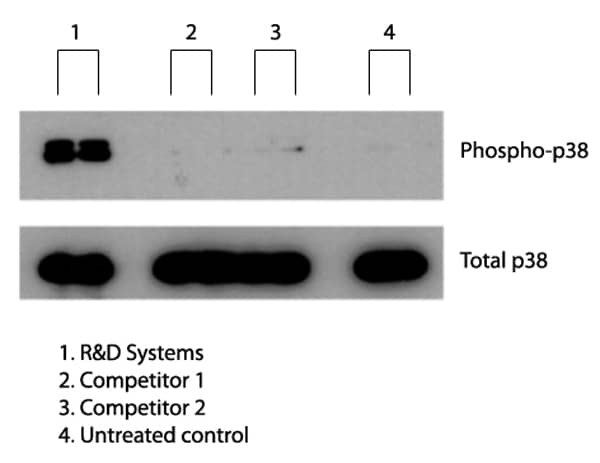Recombinant Human/Mouse/Rat Irisin Protein
R&D Systems, part of Bio-Techne | Catalog # 8880-IR

Key Product Details
Product Specifications
Source
Asp32-Glu143, with a C-terminal 6-His tag
Purity
Endotoxin Level
N-terminal Sequence Analysis
Predicted Molecular Mass
SDS-PAGE
Activity
1 μg/mL of Recombinant Human Irisin can effectively induce p38 MAPK activation.
Reviewed Applications
Read 1 review rated 4 using 8880-IR in the following applications:
Scientific Data Images for Recombinant Human/Mouse/Rat Irisin Protein
Recombinant Human Irisin Induces p38 MAPK Phosphorylation in 3T3-L1 Preadipocytes.
3T3-L1 preadipocytes were incubated with 1 µg/ml of Recombinant Human Irisin for 15 minutes. The cells were lysed and Western blots were performed with anti-phospho p38 MAPK and total p38 MAPK antibodies. Experiments are shown in duplicate.Formulation, Preparation and Storage
Carrier Free
What does CF mean?CF stands for Carrier Free (CF). We typically add Bovine Serum Albumin (BSA) as a carrier protein to our recombinant proteins. Adding a carrier protein enhances protein stability, increases shelf-life, and allows the recombinant protein to be stored at a more dilute concentration. The carrier free version does not contain BSA.
What formulation is right for me?In general, we advise purchasing the recombinant protein with BSA for use in cell or tissue culture, or as an ELISA standard. In contrast, the carrier free protein is recommended for applications, in which the presence of BSA could interfere.
Carrier: 8880-IR
| Formulation | Lyophilized from a 0.2 μm filtered solution in MOPS, NaCl and TCEP with BSA as a carrier protein. |
| Reconstitution | Reconstitute at 100 μg/mL in PBS containing at least 0.1% human or bovine serum albumin. |
| Shipping | The product is shipped at ambient temperature. Upon receipt, store it immediately at the temperature recommended below. |
| Stability & Storage | Use a manual defrost freezer and avoid repeated freeze-thaw cycles.
|
Carrier Free: 8880-IR/CF
| Formulation | Lyophilized from a 0.2 μm filtered solution in MOPS, NaCl and TCEP . |
| Reconstitution | Reconstitute at 100 μg/mL in PBS. |
| Shipping | The product is shipped at ambient temperature. Upon receipt, store it immediately at the temperature recommended below. |
| Stability & Storage | Use a manual defrost freezer and avoid repeated freeze-thaw cycles.
|
Background: Irisin/FNDC5
Irisin (also known as FNDC5) is a 12 kDa glycosylated polypeptide hormone that regulates energy metabolism, stem cell differentiation, and neuronal development (1, 2). Human Irisin is synthesized as a 212 amino acid (aa) precursor encoding a type 1 transmembrane protein with a 121 aa extracellular domain (ECD), a 21 aa transmembrane domain, and a 39 aa cytoplasmic domain. The ECD of Irisin contains a fibronectin type III domain and multiple glycosylation sites. The ECD is proteolytically cleaved to release the 112 aa soluble Irisin hormone into circulation (2-5). Mature human, mouse, and rat Irisin share 100% sequence identity. Expression of Irisin is induced in skeletal muscle and subcutaneous adipose tissue during and shortly after exercise (2, 6). Irisin induces expression of peroxisome proliferator-activated receptor gamma co-activator 1 alpha (PGC1 alpha) and uncoupling protein-1 (UCP1), mitochondrial-associated metabolic proteins (7, 8). Irisin induces the transition of white adipose tissue into more metabolically active beige adipose tissue. In mice, expression of Irisin has been shown to regulate obesity and diabetes (1, 2). A similar function in humans is suggested (9). Irisin also regulates neuronal cell differentiation and neurite outgrowth in the brain and is involved in the differentiation of osteoblasts (10-14).
References
Long Name
Alternate Names
Gene Symbol
UniProt
Additional Irisin/FNDC5 Products
Product Documents for Recombinant Human/Mouse/Rat Irisin Protein
Product Specific Notices for Recombinant Human/Mouse/Rat Irisin Protein
For research use only
